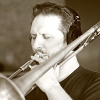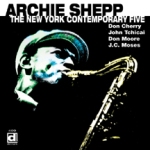Home » Jazz Articles » Live Review » The JC Sanford Orchestra At Tea Lounge: Sound Matters
The JC Sanford Orchestra At Tea Lounge: Sound Matters
Tea Lounge
Brooklyn, NY
September 20, 2010
While Manhattan gets most of the ink when it comes to live jazz in New York, it isn't the only borough where exciting things are happening. Over the past few years, Brooklyn has become a hub of activity for creative music artistry and modern thinking musicians, and one need go no further than Tea Lounge to check out the burgeoning big band scene in Brooklyn.
This hip little coffee house/bar has played host to a different big band every Monday night since March of 2010, and curator JC Sanford sees to it that the finest large ensembles around get to perform. Sanford's own orchestra had the opportunity to play as part of this appropriately named "Size Matters" series and, more importantly, his group demonstrated that sound matters. The trombonist-composer-conductor writes in an audacious—yet intellectual—manner that taps into everything from twentieth century classical composition to swing traditions, and free jazz to aggressive odd-metered rock assaults.
The first set began with some short, urgent phrases that were spread across the ensemble and these brief fragments coalesced to form a greater whole. The rhythm section immediately took the baton after this idea ran its course. Kenny Berger and Ben Kono—on bass clarinet and clarinet, respectively—each delivered some intense solo work and tangled with one another. Stand tapping—creating an interlocking rhythmic collage—and Buddhist chanting also came into play before the multi-dimensional "Rhythm Of The Mind" reached its conclusion. While Sanford spent a good amount of time conducting the orchestra through his finely calibrated compositions, he managed to fit in some engaging soloing on "Chuck and Jinx." This piece, which featured some terrific short drum set-ups from Ted Poor, was the only swing based tune on the program, easily ranking as the most conventional performance of the set.
"Indecent Stretch" began with Poor's brushes dancing over a single low brass voice. Little by little, a player at a time was added to the mix—thickening the sound on the low end—and the rhythm section quickly grasped control, laying down a brooding riff in seven. Sanford conducted the horns, which sounded brilliantly disembodied with their stretched phrasing working over the busy and imposing rhythmic undercurrent. Poor poured his soul into an interesting drum solo that lead into a loose-limbed, searching section of music featuring tenor saxophonist Chris Bacas. Some calculatedly caustic moments also came through here and the ensemble built a giant wall of sound into the piece.
Throughout the set, Sanford proved to be a brilliant chordal architect, creating tightly voiced chords that were, simultaneously, maddening and marvelous as they enveloped the whole room in an aural haze. "An Attempt At Serenity" is Sanford's musical representation of the struggle between positive and negative energy, with guitarist Andrew Green representing the latter characteristic and clear toned trumpet wonder Nadje Noordhuis representing the former. Light woodwind textures—delivered via flute and clarinet—were present at the outset and an eerie build-up of close intervals on the high-end lead into a deep, cavernous chord from the band. Green's playing came off as appropriately devilish during his turn and Noordhuis, arriving over some arco bass work from Aidan Carroll, was like a ray of sunshine. Sanford used the ensemble to create one of the aforementioned, ever-thickening chords here and the band demonstrated a textbook case of creating long form tension and release as the voices shifted ever-so slightly. An epic chordal crescendo bolstered the dueling voices of Noordhuis and Green and, in the end, the positive trumpet triumphed.
"Your Word Alone" closed out the first set and featured rising-star violinist Christian Howes and Kono. Steady quarter notes underscored the music at first, creating imagery of troops marching in the distance, and the feel of the song moved toward a bastardized, woozy ballroom tango at a few points. Howes' solo, more "out" than "in," was a real treat and the ensemble's volume was definitely near-deafening by the end of the song. The rhythm section delivered some scorching rock riffery—alternating between bars of four and five—as they lit up the room with their intense performance. Nobody would argue that size matters when it comes to ensembles, but conception, composition, execution and individual personalities matter to this group too. That's what makes the JC Sanford Orchestra so sensational.
Tags
JC Sanford
Live Reviews
Dan Bilawsky
United States
Kenny Berger
Ben Kono
Ted Poor
Andrew Green
Nadje Noordhuis
Aidan Carroll
Christian Howes
PREVIOUS / NEXT
Support All About Jazz
 All About Jazz has been a pillar of jazz since 1995, championing it as an art form and, more importantly, supporting the musicians who make it. Our enduring commitment has made "AAJ" one of the most culturally important websites of its kind, read by hundreds of thousands of fans, musicians and industry figures every month.
All About Jazz has been a pillar of jazz since 1995, championing it as an art form and, more importantly, supporting the musicians who make it. Our enduring commitment has made "AAJ" one of the most culturally important websites of its kind, read by hundreds of thousands of fans, musicians and industry figures every month.





















